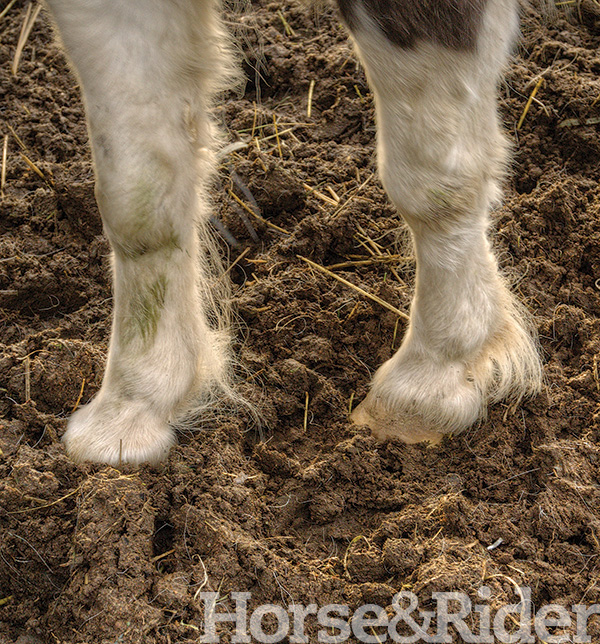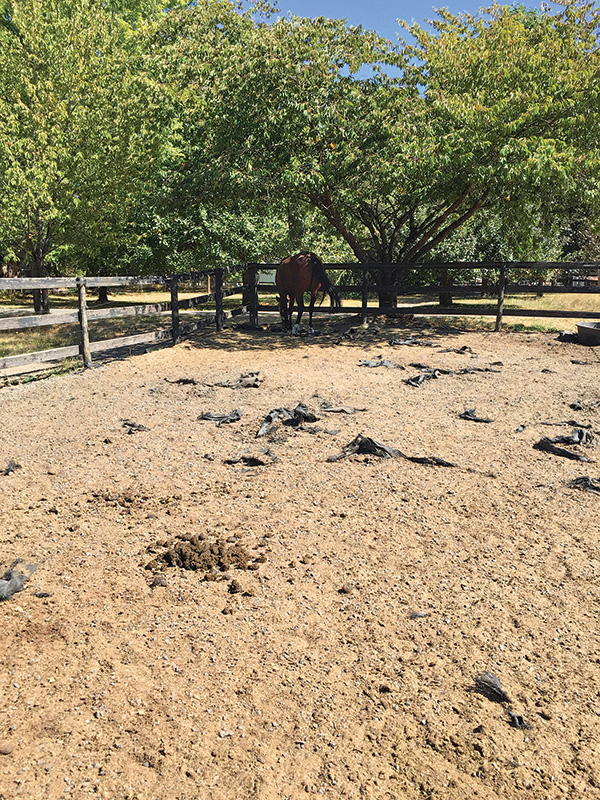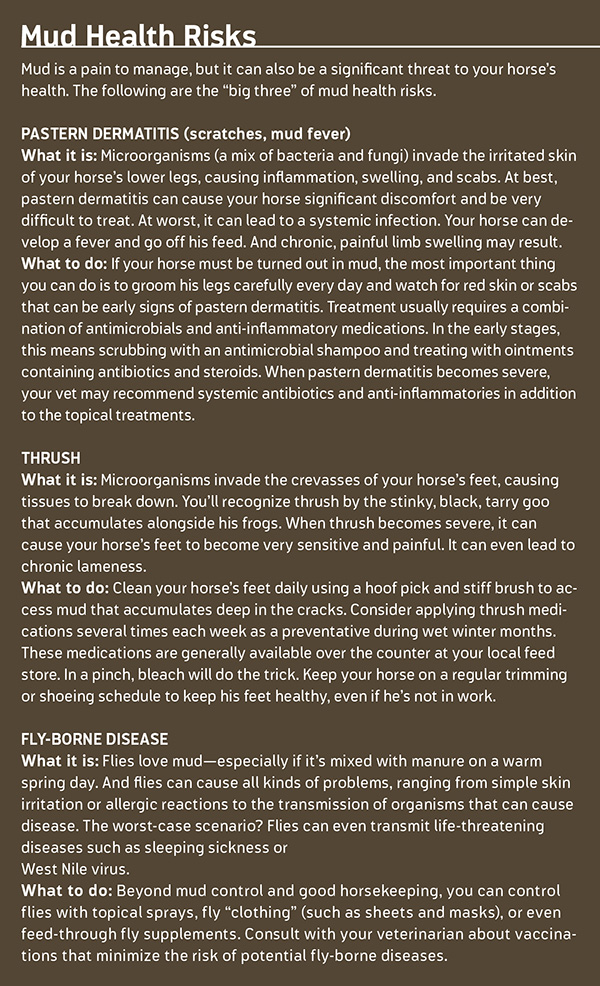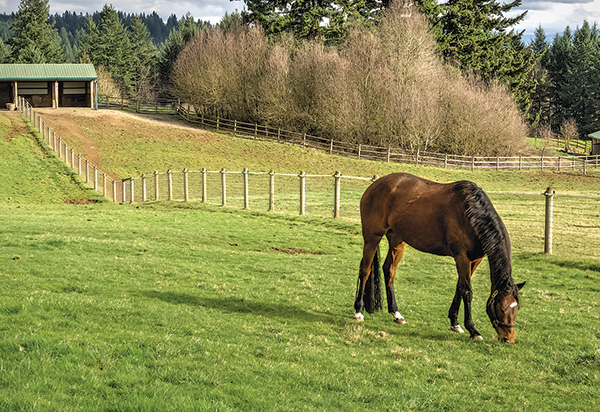Clients often ask why I wear clogs to work. “So I can only go in mud that’s less than ankle deep,” I explain. I learned this tactic soon after I walked into a muddy paddock wearing very mud-appropriate boots to vaccinate a horse. The mud was so deep it sucked those boots right off my feet.
Read More: 7 Worst Mistakes in Equine Hoof Care

“No more,” I thought. “Off with the rubber boots, and on with the clogs.” Now the horses have to come to me instead.
In this article, I’ll discuss the most important mud-management tips I’ve learned during my years in equine practice. From facility design to maintenance strategies, I’ll tell you what to do and how to do it. If you follow my lead, you’ll be that much closer to a mud-free horse life.
Top 10 Tips
An effective mud-control strategy begins the day you plan to develop a horse property and never ends. The following are my top 10 tips to help you manage mud.
[READ: Keep Your Horse in a Vet-Friendly Barn]
Tip #1: Plan it out.
If you’re lucky enough to develop a property from scratch, the layout of your facility is the perfect place to start your mud-management plan. Place buildings on high ground, and situate paddocks on a slope whenever possible, with gates, loafing sheds, and feeding areas at the highest point. A two- to five-percent grade is ideal for proper drainage. Avoid any arrangement where horses are encouraged to congregate on low ground where there’s likely to be standing water.
Tip #2: Thoughtfully place gutters and downspouts.
When you design your buildings, be sure to include properly installed gutters and downspouts that’ll divert water to an appropriate location. An inch of rain on a 20-by-50-foot roof can produce as much as 620 gallons of water per year. That’s a lot of water that contributes to the mud accumulating at the corners of your barn, arena, or loafing sheds if it isn’t diverted away. Consider covering downspouts in sheds where horses congregate with PVC pipe or a wood frame to protect them from curious equines. And once gutters and downspouts are installed, put them on a regular maintenance plan: clean gutters annually, and replace or repair broken downspouts regularly.
Tip #3: Consider your footing.
When setting up pastures or paddocks, choose and install footing carefully under loafing sheds; in sacrifice areas (more on that in a minute); and around water troughs, feeders, gates, or any other area where horses congregate (and people have to walk).

My favorite recipe for footing to control mud involves gravel—lots of it! We installed a foot of ¾-minus, compacted it, and put 6 inches of ¼-minus on top. The “minus” designation means the gravel includes small lines, and will compact well. The ¼-minus top layer is easier on the horses’ feet, avoiding sole bruises or abscesses that might develop from walking on the larger rocks. It’s also easy to rake and clean. While gravel might find its way into the soil and disappear eventually, adding layers only makes the footing better and better over time.
Other common options include sand and wood products (“hog fuel”). In my experience, sand doesn’t hold up well and quickly disappears as it mixes in the soil. Wood products are great when first installed, but break down after several years. If you choose to put down a layer of hog fuel in high-traffic areas, be prepared to remove and replace it after two to three years. Don’t make the mistake of adding another layer or you’ll soon find yourself in chest-deep mud.
Finally, road fabric is often recommended to keep footing where it belongs by preventing it from disappearing into the existing soil. Even with careful installation (deep beneath the footing with edges well buried) my experience says that busy horses that paw and cavort in their paddocks often manage to uncover fabric, which then becomes a nightmare to remove—bringing all of the footing along for the ride.
Amazon offers ArmorLay commercial-grade road fabric.
Tip #4: Establish extra drainage.
Even with a carefully thought-out site plan and properly functioning gutters and downspouts, chances are you’ll find yourself with problem areas where water accumulates. As soon as you identify these places, do something about them before mud gets out of hand. Consider installing “water bars,” a kind of speed bump for water that redirects it toward an area with better drainage. French drains are also easy to construct simply by digging a ditch and filling it with drain rock, and will help carry water to desired drainage areas. If you install French drains in pastures or paddocks where horses live, drains will still function properly if covered with ¼-minus gravel to protect horses’ feet.
Tip #5: Keep it clean.
Organic material makes bad mud worse. Not only is it deeper, gooier, and messier, mud with a high poop content provides a perfect environment for flies to flourish and microorganisms to accumulate. Clean your paddocks regularly—especially graveled areas and spaces with high horse traffic. The best-managed farms go as far as cleaning manure from bigger pastures. For very large pastures, cleaning areas with large accumulation, combined with intermittent dragging to spread remaining manure and encourage it to break down is an acceptable alternative.
Purchase a DuraFork pitch fork to help keep your paddocks clean.
Read More: Run-In Sheds for Horses
Tip #6: Feed carefully.
Never feed horses on grass or pre-existing mud. Instead, feed in feeders placed on gravel (or whatever footing you’ve chosen). Feeding hay on the grass pasture will contribute to vegetation breakdown, and leftover hay scraps will break down in the soil, adding organic material to the mix and making mud worse. Remember: All graveled areas should be raked and cleaned daily, which will prevent any hay scraps from breaking down and contributing to mud.

Tip #7: Don’t overcrowd.
Perhaps the most important factor for keeping pastures in good shape and paddocks mud-free is to avoid overcrowding. Horses are big, active animals—often wearing steel shoes as they cavort in the pasture, tearing up the grass and churning up the mud. They’re also extremely efficient grazers and will graze grass very short, which will contribute to vegetation breakdown. There’s no doubt about it: Less horse traffic means less mud. As a rule of thumb, each horse should have between one and two acres of pasture available for a full-time turned-out lifestyle.
If that space isn’t available, consider setting up sacrifice areas on your farm—gravel paddocks where horses can be kept to protect grass pastures during rainy periods. If sacrifice areas aren’t an option, you might have to cut back turnout time, especially during winter months.
Tip #8: Schedule rest.
Even if you’re able to keep numbers down, it’s still important that your pastures or paddocks have periods of complete rest each year. Plan your turnout so that you always leave an empty space. Each turnout area will usually require at least a month or two of rest each year—more if it’s very broken down or in bad shape. If it isn’t possible to rest a pasture completely, block off areas that need rejuvenation with temporary fencing to give grass a chance to regrow.
Read More: Barn Life, Made Easy
Tip #9: Manage pastures.
Healthy grass is the perfect alternative to mud; and if grass is healthy, it’s less likely to break down under the demands of grazing horses. A happy pasture requires careful management. Collect a soil sample every few years and submit it for analysis. Your local feed store can probably recommend a lab to analyze the sample. Based on the results, you should determine what additives your soil requires, including fertilizer, lime, or other minerals.
Purchase lime for your pasture on Amazon! Consider Jolly Gardner’s lawn lime.

Fertilizing is best done in the fall, when weeds have died back and grasses are dormant, allowing fertilizer to impact the roots. Grass with a healthy root system is more likely to flourish, and deeper roots can reach farther in the ground for water, allowing pastures to survive even during dry summer months.
The pH of your soil is equally important. If the pH is too low, the nutrients will be unavailable for absorption by the grasses. Lime helps to raise the pH of your soil, and can be added at any time of year.
Finally, occasional over-seeding will help fortify the grass and keep it growing strong. Although it’s best to seed when pastures are resting, you can still get good results as long as the area isn’t too overcrowded. In fact, horses’ hooves can help push the seed into the soil and encourage it to grow. If you have completely bare areas that require more renovation, use temporary fences to protect the areas while grasses grow.
Consider planting more grass seed to help grass regrow. Purchase grass seed on Amazon! Try Scotts Thick’r Lawn!
Tip #10: Protect your horse’s legs.
Even with a perfectly designed facility; ideal footing; and healthy, rested, well-managed pastures, you’ll still have mud from time to time. There are a couple of different strategies you can consider to protect your horse’s legs and prevent skin infections. If you can, avoid trimming hair away from fetlocks and pasterns. Long feathers on your horse’s fetlocks provide an excellent barrier from moisture and will prevent mud from contacting his skin. Be sure to clean them carefully several times each week, and inspect the skin underneath to ensure that it’s still healthy. If you must trim your horse’s legs, consider a thick application of Desitin ointment over the pastern area to act as a moisture barrier and prevent bacteria or other organisms from gaining ground.
Purchase Desitin ointment on Amazon!
My own horse property is now a maze of gravel, French drains, and water bars. Gutters (usually) function properly, and down spouts seem to be constantly in some state of repair. One of my pastures is currently empty, and all of my pastures were cleared of manure before winter set in. Fertilizer and lime has been applied, and a couple of areas have been seeded. You wonder if I have mud? Absolutely. But not much. And none where I actually have to walk. In fact, I can even feed the pasture horses wearing white tennis shoes…and still plan to wear them on another day.






